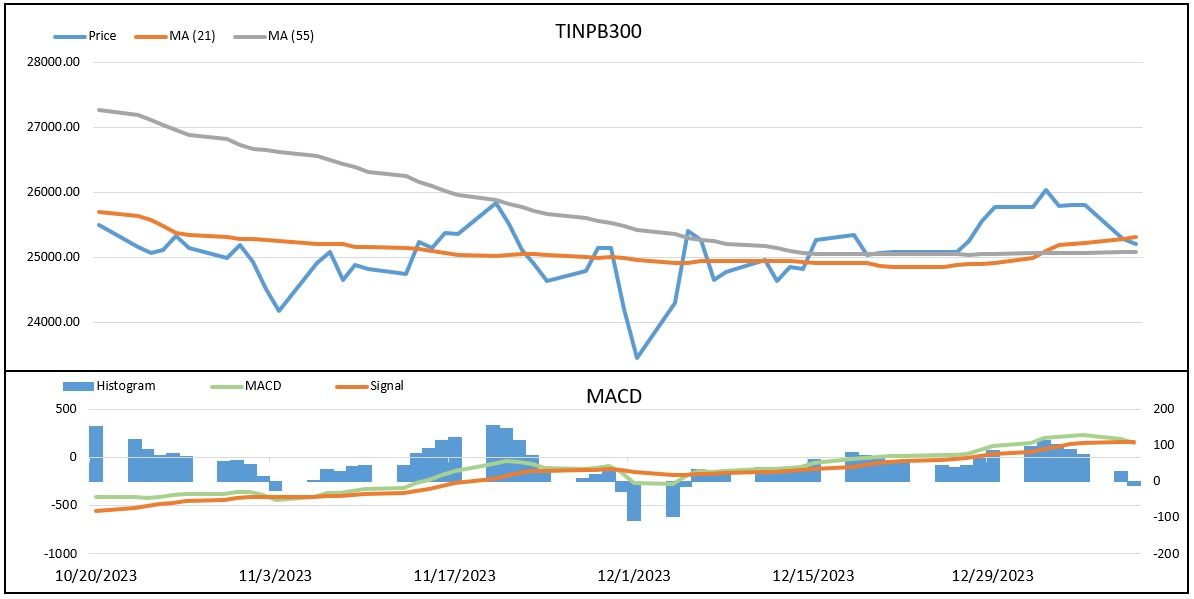Price Indicator
Product | Price | % change |
ICDX | $25,190 | -0.40% |
LME | 24,550 | 0.61% |
KLTM | NA | - |
SHFE | 205990 | 0.53% |
USD/IDR | 15559 | 0.24% |
Focus :
- Release of Chinese economic data
- Geopolitical Turmoil
Market Review
ICDX tin prices weakened 0.40% compared to the previous week due to the release of mixed data from weakening China as the world's largest tin consumer.
The National Bureau of Statistics reported that the Consumer Price Index (CPI) in China fell for the third consecutive month, by 0.3% YoY in December. Additionally, the Producer Price Index (PPI), which measures the cost of goods at the factory level, fell 2.7% YoY in December, marking the 15th consecutive month of decline. This data fueled market speculation that the government would announce additional stimulus to overcome the risk of deflation.
Meanwhile, China's Trade Balance for December, in Yuan terms, came in at CNY540.90 billion, widening from the previous figure of CNY490.82 billion. Exports jumped 3.8% YoY in December versus 1.7% in November signaling that global trade is starting to recover. However, imports fell 0.3% YoY, indicating sluggish domestic demand and adding to concerns about a slow economic recovery.
China is the world's largest tin consumer, where demand from Panda Country can influence world tin prices in the future, when demand rises, prices follow or vice versa, so China's economic conditions have a big influence on tin price movements.
Market View
Escalation of Geopolitical Unrest on World Commodity Prices
The war in the Red Sea has the potential to trigger an increase in the prices of energy, food and metal commodities. This is because the Red Sea is an important shipping lane for global trade. If this shipping route is disrupted, the supply of commodities to the global market will decrease, so that commodity prices will increase.
The Houthi group in Yemen continues to show their support for Hamas by re-launching attacks on commercial ships in the Red Sea that are believed to be helping Israel. The attack triggered a significant drop in ship traffic through the Suez Canal, with a 30% drop in the period January 1-11 compared to the previous year, according to Osama Rabie, Suez Canal Authority. As a result of the Houthi attacks, the United States has announced a new international mission to patrol the Red Sea and prevent attacks on commercial vessels. On the other hand, US and British troops reported shooting down 21 drones in response to maintaining security in the Red Sea.
If the war in the Middle East disrupts the production and export of various commodities, especially from the Middle East, it will cause an increase in commodity prices on the global market. Apart from that, war in the Middle East can also increase logistics costs, so that commodity production costs will also increase. This will also encourage an increase in commodity prices in general.
WEEKLY ECONOMICS DATA AND AGENDA
Date | Data / Events | Actual | Expectation | Previous | |||||
11 Jan | USD - Core CPI m/m | 0.30% | 0.3% | 0.3% | |||||
11 Jan | USD - CPI m/m | 0.3% | 0.2% | 0.1% | |||||
11 Jan | USD - CPI y/y | 3.4% | 3.2% | 3.1% | |||||
11 Jan | USD - Unemployment Claims | 202K | 209K | 203K | |||||
12 Jan | CNY - CPI y/y | -0.3% | -0.4% | -0.5% | |||||
12 Jan | CNY - PPI y/y | -2.7% | -2.6% | -3.0% | |||||
12 Jan | CNY - Trade Balance | 541B | 520B | 491B | |||||
12 Jan | USD - Core PPI m/m | 0.0% | 0.2% | 0.0% | |||||
12 Jan | USD - PPI m/m | -0.10% | 0.1% | -0.1% | |||||
Source : ICDX Research
- Minyak Melambung Didukung Beragam Katalis Positif
- Harga Emas Bertahan Walau Data GDP AS Menurunkan Harapan Pemangkasan Suku Bunga
- Kenaikan USDJPY Menunggu Risalah Pertemuan BOJ
- Rilisnya Data Penjualan Ritel Yang Lemah Picu Kenaikan USDCAD
- Emas Kembali Bangkit Ditengah Tingginya Imbal Hasil Treasury AS dan Penantian Laporan GDP AS








